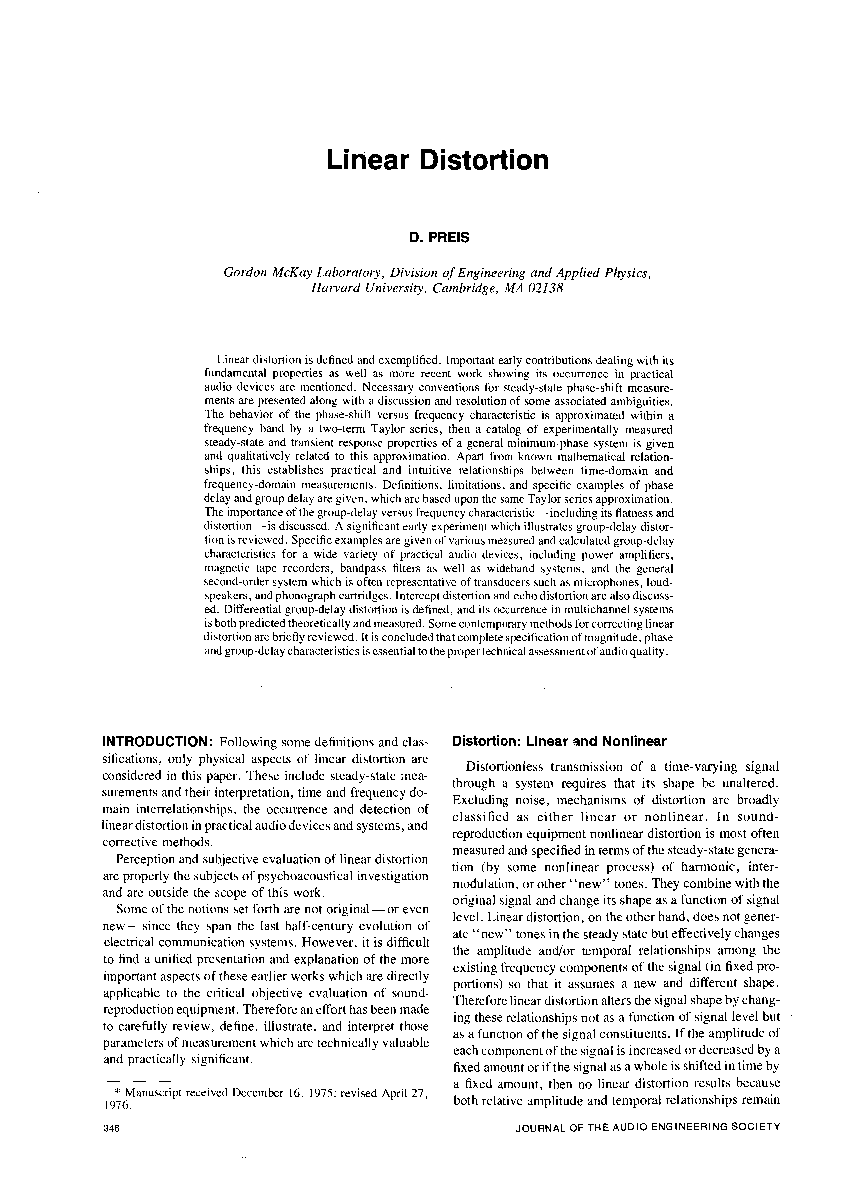Home / Publications / E-library page
You are currently logged in as an
Institutional Subscriber.
If you would like to logout,
please click on the button below.
Home / Publications / E-library page
Only AES members and Institutional Journal Subscribers can download
Linear distortion is defined and exemplified. Important early contributions dealing with its fundamental properties as well as more recent work showing its occurrence in practical audio devices are mentioned. Necessary conventions for steady-state phase-shift measurements are presented along with a discussion and resolution of some associated ambiguities. The behavior of the phase-shift versus frequency characteristic is approximated within a frequency band by a two-term Taylor series, then a catalog of experimentally measured steady-state and transient response properties of a general minimum-phase system is given and qualitatively related to this approximation. Apart from known mathematical relationships, this establishes practical and intuitive relationships between time-domain and frequency-domain measurements. Definitions, limitations, and specific examples of phase delay and group delay are given, which are based upon the same Taylor series approximation. The importance of the group-delay versus frequency characteristic-including its flatness and distortion-is discussed. A significant early experiment which illustrates group-delay distortion is reviewed. Specific examples are given of various measured and calculated group-delay characteristics for a wide variety of practical audio devices, including power amplifiers, magnetic tape recorders, bandpass filters as well as wideband systems, and the general second-order system which is often representative of transducers such as microphones, loudspeakers, and phonograph cartridges. Intercept distortion and echo distortion are also discussed. Differential group-delay distortion is defined, and its occurrence in multichannel systems is both predicted theoretically and measured. Some contemporary methods for correcting linear distortion are briefly reviewed. It is concluded that complete specification of magnitude, phase and group-delay characteristics is essential to the proper technical assessment of audio quality.
Author (s): Preis, Douglas
Affiliation:
Gordon McKay Laboratory, Division of Engineering and Applied Physics, Harvard University, Cambridge, MA
(See document for exact affiliation information.)
Publication Date:
1976-06-06
Import into BibTeX
Permalink: https://aes2.org/publications/elibrary-page/?id=2618
(2298KB)
Click to purchase paper as a non-member or login as an AES member. If your company or school subscribes to the E-Library then switch to the institutional version. If you are not an AES member Join the AES. If you need to check your member status, login to the Member Portal.

Preis, Douglas; 1976; Linear Distortion [PDF]; Gordon McKay Laboratory, Division of Engineering and Applied Physics, Harvard University, Cambridge, MA; Paper ; Available from: https://aes2.org/publications/elibrary-page/?id=2618
Preis, Douglas; Linear Distortion [PDF]; Gordon McKay Laboratory, Division of Engineering and Applied Physics, Harvard University, Cambridge, MA; Paper ; 1976 Available: https://aes2.org/publications/elibrary-page/?id=2618